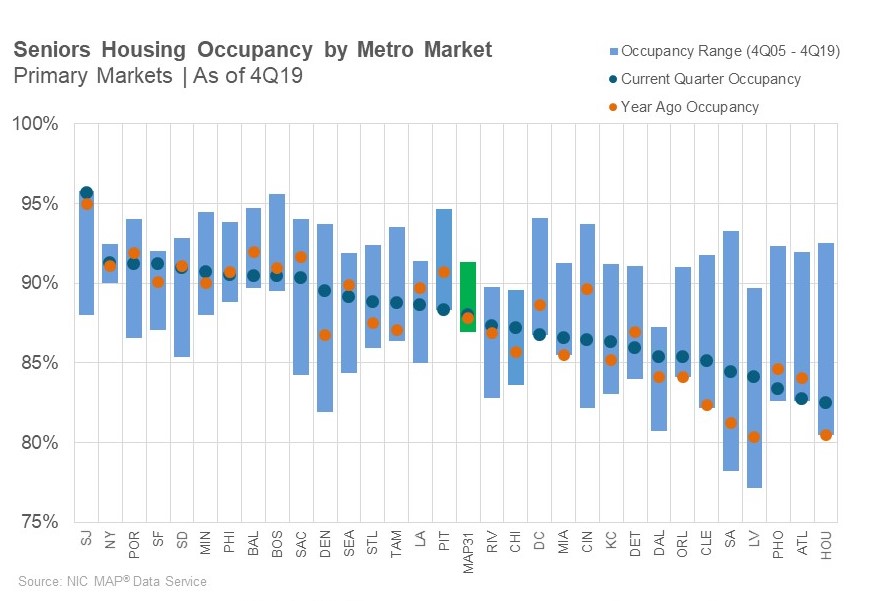Last year NIC launched seniorcare.nic.org, a website offering the latest information on seniors housing and care collaborations with the healthcare sector. Providing curated resources and news articles relevant to the new partnerships, innovations, and business deals that are reshaping America’s seniors housing and healthcare landscape, the site offers insights into the rapid evolution of senior care.
In 2019, we posted more than 150 articles on seniorcare.nic.org, from a wide variety of outlets, including the Wall Street Journal, The New York Times, NPR, Forbes, The Boston Globe, every seniors housing and care sector journal, several medical journals, and a growing number of healthcare industry outlets, such as Modern Healthcare, Fierce Healthcare, and Home Health Care News, among others.
Judging by the quantity and size of deals announced just in the latter half of 2019, it appears that numerous organizations—including some of the nation’s largest businesses—are taking steps to adapt to a changing landscape. Stories highlighted the innovative new business models, technological advances, and emerging business strategies which are having an impact on the world of healthcare – and on seniors housing and care.
Below are a few journalistic highlights from the past several months, each of which illustrates a key trend that is reshaping housing and healthcare for America’s seniors.
Big Deals:
Many business relationships are being formalized, largely in response to the new challenges and opportunities presented by an evolving healthcare system, shifting demographics, advancing technologies, and the overarching need to improve outcomes at lower cost. A review of the headlines reveals new deals and partnerships, big and small, all of which may potentially impact the sector. Major recent deals include:
Walmart and Doctor on Demand and Amedisys
CVS and Aetna
Maplewood Senior Living and Penn Medicine
Leverage Health and WellBe Senior Medical
Amazon and PillPack and Health Navigator
Microsoft and Humana
Medica, Genevive, Presbyterian Homes & Services – and 9 other Senior Living Companies
Welltower and CareMore and Senior Resource Group and Belmont Village
Best Buy and GreatCall and Critical Signal Technologies
Sam’s Club and Humana and 98point6
New Partnerships:
Forbes senior contributor Bruce Japsen outlined the newly announced partnership between Microsoft and Humana. The headline, “Microsoft, Humana Partner To ‘Reimagine’ Healthcare For Aging Boomers” reflects growing awareness of the opportunity inherent in a huge population that is growing older and will otherwise stress the current system to its breaking point.
“With an estimated 10,000 people joining the Medicare system daily, we have a tremendous opportunity to address the growing demands on the health care system by improving health outcomes and lowering costs,” Microsoft corporate vice president of health technology and alliances, Dr. Greg Moore, said in a statement announcing the partnership.
“The next step for medical records is to go beyond the collection of information to the delivery of insights,” Humana chief medical and corporate affairs officer Dr. William Shrank said. “Microsoft technologies offer Humana the ability to apply sophisticated analytics to our members’ records, and in turn, provide clinicians and care teams with the opportunities to make a difference in patients’ health.”
Senior Housing News highlights another recent partnership in Tim Mullaney’s article, “Welltower, CareMore Initiative Drives Senior Living Integration with Medicare Advantage”. As Mullaney writes, “The participating organizations anticipate that the initiative will lead to improved health and wellness for senior housing residents, which in turn will reduce hospitalizations and other costly interventions and increase length of stay.” CareMore, which is affiliated with Anthem, one of the nation’s largest health insurers, was looking to scale its successes working with senior living providers on a facility-by-facility basis, according to Dr. Sachin Jain, CareMore’s president and CEO:
“As we started to think about how we could make an even greater impact on American health care and further refine this model, we started to look for broader national partners,” Jain said. “Welltower was an obvious choice.”
For its part, Welltower, a REIT with a portfolio of about 1,300 properties nationwide, is pursuing a strategy that anticipates healthcare increasingly moving out of hospitals and into residences. It is building closer relationships with healthcare systems and payers, while shifting the focus of care – and value – into the senior living realm.
As Welltower Senior Vice President of Business Strategy and Health System Initiatives Mark Shaver said, “We believe this will make our sites of care more consequential.”
New Models:
Within the space of a week last fall, three of America’s biggest retailers announced plans to leverage health care’s move to the home. The Home Health Care News article, “Best Buy, Amazon and Walmart Leading Retail’s Race into Home-Based Care”, by Bailey Bryant, summarizes the separate plans, all of which place big bets on a major shift in the delivery of healthcare in America.
Best Buy announced its goal of supplying “5 million seniors with health monitoring services in five years.” Analysts at Morgan Stanley said of the company’s plans that, “Looking ahead, we believe Best Buy’s deeper push into health monitoring, related efforts to reduce medical expenses for insurers, and right to share in the cost savings represent a significant revenue and profit opportunity in the long term.” The company’s healthcare moves could bring in an additional $46 billion in long term revenues – which is more than Best Buy’s current annual revenues of $43 billion.
The article goes on to point out that, “When it comes to in-home care, Amazon is getting its toes wet with employees first. Last week, the company announced the rollout of Amazon Care, a new virtual care clinic pilot available to Seattle-based employees and their dependents.”
Walmart is also mentioned, “Finally, Walmart is getting in the home-based care game with a prototype of its new Walmart Health clinic, which features an Amedisys Inc. (Nasdaq: AMED) kiosk designed to help educate customers and potential patients on home health services.
Innovation:
A HealthLeaders article by Christopher Cheney, “Walmart, Doctor on Demand Join Forces in Primary Care Telemedicine Deal,” discusses how the retail giant plans to use telehealth to deliver quality primary care to its employees, who pay a $4 copay.
As Cheney writes, “The new partnership provides primary care and behavioral health services via video-based telemedicine to Walmart employees and their dependents in Colorado, Minnesota, and Wisconsin.
According to Doctor on Demand CEO, Hill Ferguson, “We can help patients manage chronic conditions from the comfort of their home, keep them out of the emergency room, and make sure that if they need in-person care that we can route them to the right place where they will optimize for quality and cost.”
Modern Healthcare recently published Shelby Livingston’s article, “CVS’ first HealthHUBs driving more prescriptions, clinic visits,” delving into what appears to be a major early success for the pharmacy giant’s innovative new pilot program.
As Livingston summarizes, “The HealthHUB locations cater to everyday needs, with a special focus on chronic disease management, offering services like blood draws, sleep apnea assessments and diabetes care. Patients can access one-on-one and group counseling with a dietitian in the store. The stores also feature a care concierge to educate customers about the services and connect them with in-store providers.”
Venture “Catalyst” firm Leverage Health and WellBe Senior Medical announced a strategic partnership to “provide specialty geriatric care to frail, polychronic seniors in Medicare Advantage health plans.”
A McKnight’s Long-Term Care News piece, titled “Leverage Health backs WellBe concept in new partnership,” by Kimberly Marselas, quotes WellBe founder and CEO, Jeff Kang, “Building a deep relationship with our patients and physically being in the home allows our team to address both clinical and social determinants of health directly. The result is immediate, dramatic improvement to the person’s overall health and wellbeing as we follow the patient across every care setting.”
The pieces referenced above are just a sampling of those available on www.seniorcare.nic.org. Our team regularly updates a growing list of articles, specially curated for relevance. To stay on top of what’s happening across the seniors housing and care spectrum, in terms of collaborations, partnerships, and innovations involving healthcare, keep an eye on our list, and link to the growing body of journalism that is tracking how our system is evolving, as it happens.
This is an updated version of an article that originally appeared in the Housing & Healthcare blog on seniorcare.nic.org in November 2019.










